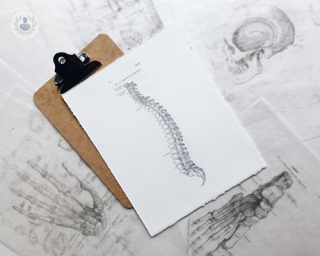Spinal injections
Mr Robert Lovell - Orthopaedic surgery
Created on: 07-27-2020
Updated on: 10-02-2023
Edited by: Conor Dunworth
What are spinal injections?
Your spine is made of various bones called vertebrae. These are connected to one another and allow your spine to move, they also protect the nerves and spinal cord. These interconnections are made up of intervertebral discs (they act as a spine’s shock absorbing system) and facet joints (these connect the vertebrae to one another).

Due to many reasons, these structures can wear down and, with time, can cause pain. Spinal injections deliver medicines near our spine, normally around the source of your pain.
Two medicines can be used in spinal injections:
- local anaesthetic which is used to stop pain in the injected area
- steroids which is used to reduce inflammation and swelling in the injected area.
The aim of a spinal injection is to ease back or arm/leg pain, or sometimes both, for up to three months.
There are four injection techniques that are often used by doctors:
- Epidural injection targets the space that surrounds the spinal cord.
- Sacroiliac and facet joint injections target the joints that link the bones of your spine.
- Nerve root injection targets individual nerves in the spine.
- Discography targets the intervertebral discs between the bones of your spine. The type of spinal injection is usually based on the specific symptoms in the spine.
Why are spinal injections done?
Spinal injections are used for therapeutic or diagnostic purposes. A diagnostic spinal injection can sometimes help a surgeon plan the long-term management of the condition being treated. It's very useful when a patient's source of pain has not been clearly identified before, and it can determine the spinal structure that is causing symptoms.
A therapeutic spinal injection improves symptoms with the use of steroids and local anaesthetic to reduce inflammation and swelling. It can be repeated periodically if it works well and allows patients to progress with other treatments such as physiotherapy.
What do spinal injections involve?
An anaesthetist would review the patient's fitness for surgery and finalise the planned anaesthetic regime. The patient would have to sign a consent form. They would then be taken to a operating theatre or radiology suite for treatment. Usually, a patient would have to lie on their stomach, but they may be asked to lie on their side with their knees drawn up and chin tucked in. This position helps to open up space between the bones in the spine.
A sedative may be injected it into a vein in the back of the hand. After the injection site has been made sterile with an antiseptic wipe, a local anaesthetic is injected. When the area becomes numb, the doctor will carefully insert a hollow, thin, spinal needle into the spine using an x-ray machine for guidance.
If a patient is having treatment in the radiology department, a CT machine 10 (computerised tomography machine which creates detailed images of inside the body) is used to guide the spinal needle. It won't be felt when it is going in, but once it has reached the spine, the patient may feel discomfort.
It's crucial that patients do not move whilst the needle is being inserted. This is because movement makes the positioning of the needle more difficult.
Steroids and local anaesthetic are then injected into the spine of a patient has discography, a surgeon should be told about the pain in the back or leg during the procedure. When treatment is finished, the doctor will take the needle out and cover the injection site with a plaster. The treatment usually takes around 20 to 40 minutes to complete.
How do you prepare for spinal injections?
During a pre-assessment, patients should tell their doctor about any health conditions they have (for example, bleeding disorders or diabetes), and about any medicines that they may be taking, including over-the counter medicines or blood thinners. Patients may be asked to stop taking certain medicines for many days prior to the procedure.
It's important to remember that spinal injections are not suitable for pregnant women due to the x-rays that are usually used during the treatment. They can harm a developing baby. If a patient is pregnant, the doctor will talk about their alternative treatment options.
Aftercare
It's essential that a patient continues to take painkillers as advised after treatment. The management of painkillers would be discussed before the patient leaves the hospital.
Usually, the plaster can be removed after 24 hours and a shower or a bath can be had as normal. Before the plaster is removed, patients must avoid getting the injection site wet. Generally, there are no restrictions after spinal injections once the post-treatment pain has settled down.
Patients should be able to return to spinal exercises or physiotherapy within a week after their injection. Depending on the nature of the patient's job, they may wish to return to work after 72 hours.
Patients will want to ensure that their employer is happy with this arrangement. If the pain does not settle within four to six weeks, the specialist who carried out the treatment should be contacted.
Alternatives to this treatment
Other pain-relieving therapies exist and they can help ease back pain, such as pain-relieving medicines and TENS (transcutaneous electrical nerve stimulation) machine. Acupuncture, exercise, yoga/pilates and relaxation therapy may also help ease back pain.
Which type of specialist offers spinal injections?
A specialist such as an orthopaedic surgeon may offer this procedure.















